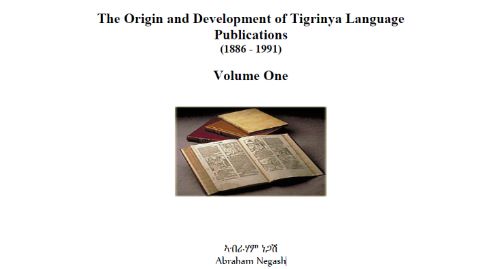The Origin and Development of Tigrinya Language Publications (1886 - 1991) Volume One

Abstract
Tigrinya is a Semitic language spoken in Eritrea and in the Tigray Region of Northern Ethiopia. Tigrinya is one of the nine languages in Eritrea. It was one of Eritrea's official languages (along with Arabic) during the short-lived federation with Ethiopia (1952-1962). When Ethiopia officially annexed Eritrea in 1962, Amharic also formally replaced Tigrinya and Arabic; and was established as an official language by the imperial government of Ethiopia. In 1993, when Eritrea officially declared its independence through referendum. Tigrinya regained its status as a working language.
Tigrinya has its own alphabet of 32 letters adopted from Ge'ez, a language which exists with a very limited function within the Coptic Orthodox and Catholic Churches. Like English, Tigrinya is written from left to right. Although the Tigrinya script might look difficult, pronunciation is simple and straightforward, as the phonetic symbols closely resemble pronunciation.
The earliest written example of Tigrinya is a text of local customary laws, dating back to the 13th century. It was found in the district of Logo Sarda, Akele Guzai in Eritrea. The first literary text in Tigrinya was published in Europe. In 1895 Feseha Giyorgis, a scholar who was studying Italian and Latin and taught Tigrinya in Naples, published a pamphlet in Rome giving an account of his journey to Italy five years earlier. He was very conscious of his trailblazing role as "the father of Tigrinya literature." In his foreword to the work he wrote that "our main drive has been to furnish those who yearn to learn Tigrinya with material for exercise." The content of the pamphlet indicates that his 3 primary audience, however, was the educated elite of his home country, as it focuses on the author's impressions of the exotic country to which he had travelled.
The first work published in Tigrinya was a translation of the Four Gospels by Dabtera Matewos. It was written in the 1830s and was published in 1866 by Isenberg, in Basle, Switzerland. The Tigrinya title is ወንጌል ቅዱስ ናይ ጎይታና ናይ ምድሓኒናን የሱስ ክርስቶስ. This work is of major significance, because it marks the first appearance of the Tigrinya language in book form as well as in a full Ge’ez script.
European missionaries were responsible for a stream of publications from the 1890s onwards, including the first Tigrinya language newspaper in 1909, but that it did not last long. During the British Military Administration in 1941-1952, Ministry of Information of the administration published a weekly newspaper in Tigrinya. At that time, a single newspaper would cost about 5 cents; the number of copies of the newspaper sold per week would reach up to 5,000. At that time, it was reported to be the first of its kind.
There is no standard bibliography of Tigrinya publications. In an effort to address this gap, I have prepared what I think is the first annotated bibliography in two volumes. I hope that this publication will provide a summary and evaluation of books written in Tigrinya that I have been able to locate and analyze. It is also my belief that this work will be of great use to researchers and future generations and will enhance the development of Tigrinya language and literature.
In compiling this work, I have traveled extensively and conducted research in libraries and archives in Asmara, Addis Ababa, Sweden, and Italy. I also interviewed and consulted with knowledgeable individuals about early publications. After collecting bibliographic information for over 760 publications, I arranged individual records in alphabetical order by author, followed by title, place and date of publication, and number of pages.
During the process of my work I have come to realize the following facts:
1. Books written in Tigrinya are far more numerous than many people realize.
2. Because of the large number of discovered publications, a published bibliography would be of great importance to researchers.
3. Most books published in Tigrinya have incomplete information regarding dates and places of publication.
The bibliography presented here is the first one of its kind. It does not, however, claim to be comprehensive. I would be very pleased if this book stimulates and encourages other researchers to make additional entries.
After 1991 the number of books published in Tigrinya has increased tremendously. Volume one of this work includes all publications before 1991. And Volume Two will include all the works published since 1991.
Citation Information
Abraham Negash. "The Origin and Development of Tigrinya Language Publications (1886 - 1991) Volume One" (2016)
Available at: http://asmarino.com/tig/docs/4859-1886-1991


![[AIM] Asmarino Independent Media](/images/logo/ailogo.png)